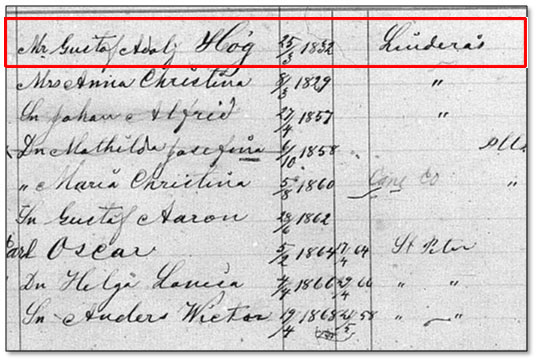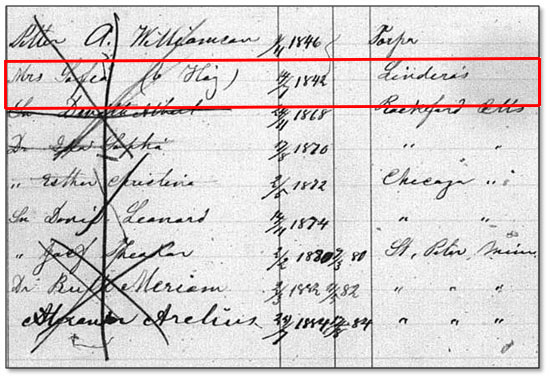March 11, 2013 – How I Became Interested in Genealogy: Comparing High Family History to Historical Records
First, let’s look back at what the 1972 High Family book said about my Swedish ancestors:

Before crossing the Atlantic to search for old European records on our ancestors, it’s a good idea to have gathered all of the American records on them first. After all, we knowthat family histories aren’t 100% reliable, but official records (such as censuses) often have mistakes as well, such as when a person was born. The actual truth about an ancestor usually becomes more concrete with each record that is found, however, so it’s important to have as much information on them as possible before attempting to find records of them in the Old Country. Thus, I started my research on the High family by using Ancestry.com to verify the information the 1972 High Family book provided on the 4 children of Sven Hög and Anna Stina Johansdotter.
To verify what the 1972 High Family book states on Sven and Anna Stina’s children, I’ll compare the information it gives on each of them to the records from the Swedish Lutheran Church, the church the four pioneers and their familiesattended after they immigratedto St. Peter, Minnesota. When I first started my research in 2006, I didn’t have the Swedish Lutheran Church, but you’ll notice that they verify the names and birth dates of all four children:
1. Margaret High Mann

Listing of Margaret High Mann in the 1972 High Family Book

Listing of Margaret High Mann’s family in the Swedish Lutheran Church
Notice that the same birth date for Margaret (also named Maja Greta) is listed on both records – April 8, 1830. The name and birth date for her husband, Jonas Mann, and children on the Swedish Lutheran Church records likewise matchwhat the High Family book lists. To the far right of Margaret’s name, the word “Linderås” is listed. Linderåsis the name of parish where Margaret was born in Sweden.
2. Gustaf Adolf High

Listing of Gustaf Adolf High in the 1972 High Family Book

Listing of Gustaf Adolf High’sfamily in the Swedish Lutheran Church
Likewise, the information here on my great-great-grandfather matches. It’s interesting to see that “Hög” is listed as Gustaf’s surname on this record. In fact, all Swedish names are given in these church records, rather than their English equivalents. Linderås is also given as the parish of Gustaf’s birth.
3. Sofia High Williamson

Listing of Sofia High Williamson in the 1972 High Family Book

Listing of Sofia High Williamson’sfamily in the Swedish Lutheran Church
What’s interesting here is that this church record shows that Sofia was born on July 14, 1842, not on July 14, 1833, as the High Family book suggests. The rest of the family information here matches, though.
4. Sven John High

Listing of Sven John High in the 1972 High Family Book

Listing of Sven John High’s family in the Swedish Lutheran Church
 The High Family book got a couple of facts wrong on the youngest son of Sven Hög and Anna Stina Johansdotter. The suffix “III” can’t be found anywhere in Sven Johan’s name. Likewise, the place it states he was born at, “Kapela Ruskgard” is incorrect. Both of these errors appear to be minor misunderstandings, however. Everything else on Sven John’s family from the two sources matches.
The High Family book got a couple of facts wrong on the youngest son of Sven Hög and Anna Stina Johansdotter. The suffix “III” can’t be found anywhere in Sven Johan’s name. Likewise, the place it states he was born at, “Kapela Ruskgard” is incorrect. Both of these errors appear to be minor misunderstandings, however. Everything else on Sven John’s family from the two sources matches.
Thus, outside of a couple of discrepancies, the Swedish Lutheran Church records validated the information given in the 1972 High Family book on Sven and Anna Stina’s children. This was enough information to enable my researcher to find records of my ancestors in Sweden.Records of Sven and Anna Stina’s family were found in Linderås, a parish located in northeastern Jönkoping County, Sweden.
Although there are a variety of different types of records that can be used for Swedish genealogy research, the most common ones are church records for baptisms, marriages, burials, and household examinations. Household examinations were designated to test the Biblical knowledge of a parish’s inhabitants, but they also serve as a census, listing the names of all of the residentsof a household, their date of birth, where they were born, and what year they moved to the parish.
A number of records for Sven and Anna Stina’sfamily can be found in Linderås Parish. In my opinion, one of the most beautiful records for their family is from the 1841-1846 Household Examinations. This record shows Sven and Anna Stina’s family living at Sörhemmet, a soldier’s croft at the farm of Kapela Ravelsgård. All four of their children are listed on this record, and their dates of birth correspond perfectly to what is written in the Swedish Lutheran Records. The names of two children who died in infancy are also listed on this record. In fact, the Sven and Anna Stina tragically had four children that died in infancy. At the bottom of the record is a listing of a maid named Maja Lena Andersdotter. I would later find out that she was Sven Hög’s youngest sister.
Every time I look at this tan record with its beautiful calligraphy, I’m filled with feelings of awe and fascination. It’s amazing to see the actual records of Sven and Anna Stina’s family from over 150 years ago!As with the records from the St. Peter Swedish Lutheran Church, I didn’t have access to the actual Swedish records until a couple of years ago. When I had research done on my Swedish ancestors back in the early days, photocopies of just a few selected records were sent to me, which fail to capture the essence of old 19th Century Sweden for me. In May of 2011, I was delighted to find Arkiv Digital, a company which offers digital images of all of the Swedish church records, as well as millions of other images.

Clerical record of Sven Hög and Anna StinaJohansdotter’s household from Sörhemmet, Kapela Ravesgård, Linderås Parish: 1841-1846
 The last question I’ll answer in this blog is: How did the research find who Sven’s parents were? If you look to the right of Sven Hög’s name on the above record, you will see the text “Solberga 01 18/1” listed. This denotes that Sven was born in Solberga (now named Norra Solberga) Parish on January 18, 1801. Norra Solberga Parish is three parishes south of Linderås Parish. Thus, one merely has to browse through the church books for Norra Solberga to find a record of Sven’s birth.
The last question I’ll answer in this blog is: How did the research find who Sven’s parents were? If you look to the right of Sven Hög’s name on the above record, you will see the text “Solberga 01 18/1” listed. This denotes that Sven was born in Solberga (now named Norra Solberga) Parish on January 18, 1801. Norra Solberga Parish is three parishes south of Linderås Parish. Thus, one merely has to browse through the church books for Norra Solberga to find a record of Sven’s birth.
Using the information from Linderås Parish’s Household Examinations, Sven’s baptism record was easy to find. However, Sven was born on January 28, 1801, not on January 18, 1801. According to this record, Sven was born at Sjöstorp, a croft (or cottage) at a farm called Havsvik in Norra Soberga.

Birth Record of Sven Andersson Hög –January 28th, 1801
 Sven’s baptism record states that his parents were Anders Andersson and Maja Pehrsdotter. However, the Household Examination for the family at Sjöstorp shows that Sven’s mother was really named Maja (or Maria) Svensdotter. Every other record associated with Sven’s mother also shows that this was her name. The Household Examination for Anders Andersson and Maria Svensdotter’s family at Sjöstorp in 1809 also mistakenly denotes that Sven was born on January 8, 1801, instead of January 28th. In fact, every household examination that Sven is listed on erroneously indicates his birth date.
Sven’s baptism record states that his parents were Anders Andersson and Maja Pehrsdotter. However, the Household Examination for the family at Sjöstorp shows that Sven’s mother was really named Maja (or Maria) Svensdotter. Every other record associated with Sven’s mother also shows that this was her name. The Household Examination for Anders Andersson and Maria Svensdotter’s family at Sjöstorp in 1809 also mistakenly denotes that Sven was born on January 8, 1801, instead of January 28th. In fact, every household examination that Sven is listed on erroneously indicates his birth date.
Despite a few discrepancies on the different records, there’s enough evidence to confirm that Sven’s parents were indeed Anders Andersson and Maria Svensdotter. There are also several more pieces of evidence which support this, but I feel that I’ve listed enough in this blog to make my point.
It’s interesting enough just to see one’sancestors names on 19th Century U.S. Census records. Viewing older European records that contain information on our ancestors is truly surreal! I just wish the generation of my grandfather could have lived to see these records.
Leave a Reply